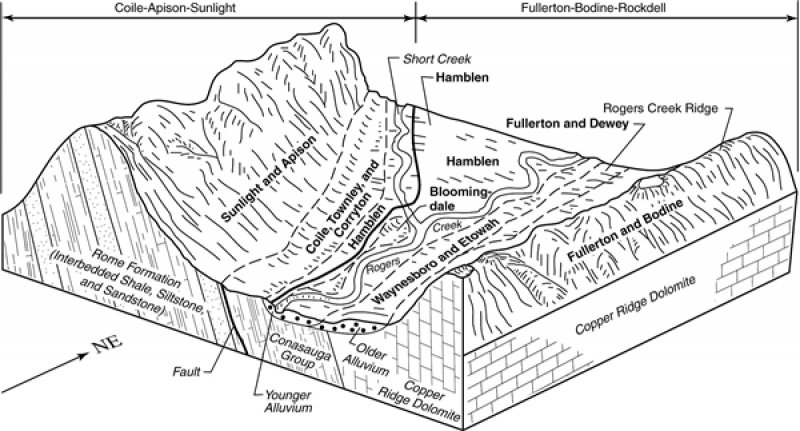
Natural Resources
Conservation Service
Ecological site F128XY501WV
Thermic Interbedded Sedimentary Uplands
Last updated: 5/14/2025
Accessed: 12/21/2025
General information
Provisional. A provisional ecological site description has undergone quality control and quality assurance review. It contains a working state and transition model and enough information to identify the ecological site.
MLRA notes
Major Land Resource Area (MLRA): 128X–Southern Appalachian Ridges and Valleys
MLRA 128 falls into the East and Central Farming and Forest Region. This MLRA is in Tennessee (36 percent), Alabama (27 percent), Virginia (25 percent), and Georgia (12 percent). It makes up about 21,095 square miles (54,660 square kilometers).
Most of this MLRA is in the Tennessee Section of the Valley and Ridge Province of the Appalachian Highlands. The thin stringers in the western part of the area are mostly in the Cumberland Plateau Section of the Appalachian Plateaus Province of the Appalachian Highlands. A separate area of the MLRA in northern Alabama is in the Highland Rim Section of the Interior Low Plateaus Province of the Interior Plains. The western side of the area is dominantly hilly to very steep and is rougher and much steeper than the eastern side, much of which is rolling and hilly. Elevation ranges from 660 feet (200 meters) near the southern end of the area to more than 2,400 feet (730 meters) in the part of the area in the western tip of Virginia. Some isolated linear mountain ridges rise to nearly 4,920 feet (1,500 meters) above sea level.
The MLRA is highly diversified. It has many parallel ridges, narrow intervening valleys, and large areas of low, irregular hills. The bedrock in this area consists of alternating beds of limestone, dolomite, shale, and sandstone of early Paleozoic age. Ridgetops are capped with more resistant carbonate and sandstone layers, and valleys have been eroded into the less resistant shale beds. These folded and faulted layers are at the southernmost extent of the Appalachian Mountains. The narrow river valleys are filled with unconsolidated deposits of clay, silt, sand, and gravel.
Classification relationships
This ESD is within NRCS Major Land Resource Area (MLRA) 128 - Southern Appalachian Ridges and Valleys. It falls within the Environmental Protection Agency's "Southern Shale Valleys" ecoregional classification (Authors: Glenn Griffith, James Omernik, Sandra Azevedo).
Ecological site concept
Taken from the EPA classification: "The Southern Shale Valleys consist of undulating to rolling valleys and some low, rounded hills and knobs that are dominated by fine-grained rock, primarily shale. The soils formed in materials weathered from shale, shaly limestone, and clayey sediments, and tend to be deep, acidic, moderately well-drained, and slowly permeable. The steeper slopes are used for pasture or have reverted to brush and mixed forest land. The forested sections are mostly mixed oak communities and some oak-hickory-pine. Pine plantations are found in some areas. Small fields of hay, corn, soybeans, tobacco, and garden crops are grown on the foot slopes and bottom land."
This site will change from south to north. In some places, hemlock will be important and pine will become more important in southern stands.
Table 1. Dominant plant species
| Tree |
(1) Quercus rubra |
|---|---|
| Shrub |
(1) Vaccinium pallidum |
| Herbaceous |
Not specified |
Click on box and path labels to scroll to the respective text.
